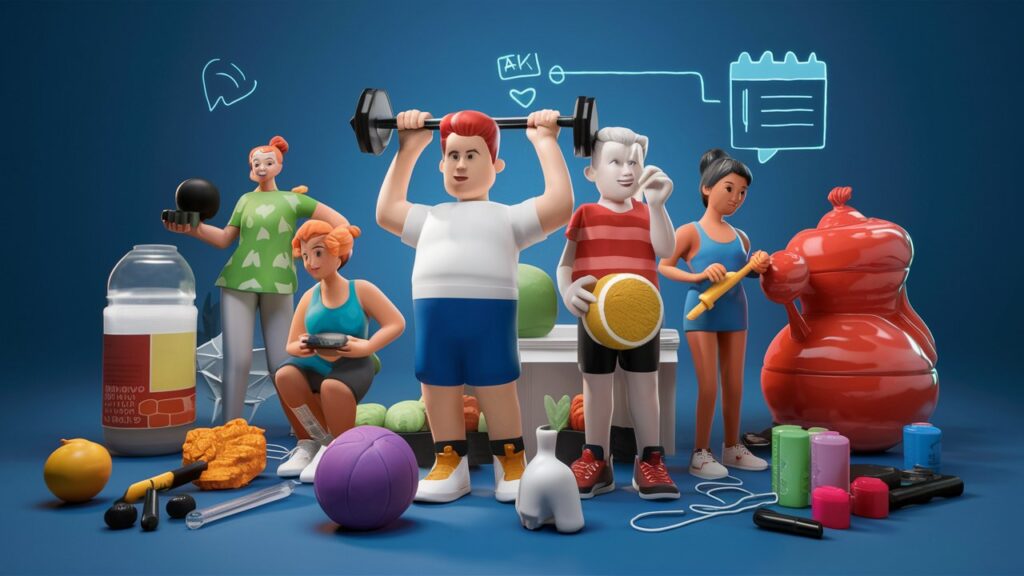Table of Contents
ToggleThe Goodness of Fitness, Starting Strong, and Improving Along the Way
Understanding the Health Benefits of Exercise
Exercise isn’t just about getting in shape; it’s about feeling good inside and out. Let’s dive into the incredible ways exercise can improve your overall health and well-being.
Physical Health Benefits

Exercise does wonders for your body, inside and out. Here’s how:
- Strengthens Your Heart: Regular exercise keeps your heart strong, reducing the risk of heart disease and stroke.
- Improves Stamina and Energy: Say goodbye to feeling tired all the time! Exercise boosts your endurance and energy levels, helping you power through your day.
- Enhances Flexibility and Mobility: Stretching and moving your body regularly keeps your muscles and joints flexible, reducing the risk of injury and improving your range of motion.
- Supports Weight Management: Exercise burns calories and builds muscle, making it easier to maintain a healthy weight and fend off obesity-related conditions like diabetes and high blood pressure.
Mental Health Benefits

Exercise isn’t just good for your body—it’s great for your mind too! Check out these mental health benefits:
- Reduces Stress: Exercise is a natural stress-buster, releasing feel-good chemicals in your brain that help you relax and unwind.
- Boosts Mood: Say hello to those happy endorphins! Exercise can lift your spirits, reduce feelings of anxiety and depression, and improve your overall outlook on life.
- Enhances Cognitive Function: Want to sharpen your focus and memory? Exercise can help! It stimulates blood flow to your brain, promoting better cognitive function and mental clarity.
- Promotes Better Sleep: Struggling to catch those Z’s? Regular exercise can help you fall asleep faster and enjoy deeper, more restorative sleep.
Emotional Well-being

Exercise isn’t just about physical health—it’s about feeling good emotionally too! Here’s how staying active can boost your emotional well-being:
- Builds Confidence: Achieving your fitness goals, whether big or small, can give you a huge confidence boost, helping you feel more self-assured and capable in all areas of your life.
- Fosters Connection: Whether you’re hitting the gym with a buddy or joining a group fitness class, exercise can be a great way to connect with others, combatting feelings of loneliness and isolation.
- Increases Self-awareness: Tuning into your body’s signals during exercise can help you become more in tune with yourself, fostering a greater sense of self-awareness and mindfulness.
- Provides a Healthy Outlet: Feeling stressed, angry, or overwhelmed? Channel those emotions into your workout! Exercise offers a healthy outlet for pent-up feelings, helping you release tension and clear your mind.
Getting Started: Overcoming Obstacles and Excuses
Starting your fitness journey can feel overwhelming, but with the right mindset and approach, you can overcome any obstacles and kickstart your path to a healthier you.
Setting Realistic Goals

Setting realistic goals is the first step towards success. Here’s how to do it:
- Be Specific: Instead of saying, “I want to get in shape,” define exactly what that means for you. Whether it’s losing a certain amount of weight, running a mile without stopping, or fitting into a specific clothing size, clarity is key.
- Make Them Attainable: While it’s great to aim high, setting goals that are too far out of reach can leave you feeling discouraged. Start with small, achievable goals, and gradually work your way up.
- Set a Timeline: Give yourself a deadline to work towards. This will help keep you focused and motivated, knowing that you have a specific target to hit.
Finding Your Motivation

Finding your motivation is essential for staying committed to your fitness journey. Here’s how to stay inspired:
- Identify Your Why: What is your reason for wanting to get fit? Whether it’s to improve your health, boost your confidence, or set a positive example for your loved ones, knowing your why will help keep you motivated when times get tough.
- Visualize Your Success: Close your eyes and imagine yourself achieving your fitness goals. Visualizing success can help reinforce your commitment and keep you motivated to push through obstacles.
- Surround Yourself with Support: Surround yourself with people who uplift and encourage you on your fitness journey. Whether it’s joining a fitness class, finding a workout buddy, or seeking support from friends and family, having a support system can make all the difference.
Creating a Sustainable Routine

Consistency is key when it comes to fitness. Here’s how to create a routine that sticks:
- Start Small: Don’t try to overhaul your entire lifestyle overnight. Instead, start by incorporating small, manageable changes into your daily routine, such as going for a short walk or doing a quick workout at home.
- Schedule Your Workouts: Treat your workouts like any other appointment and schedule them into your day. Whether it’s first thing in the morning, during your lunch break, or after work, find a time that works best for you and stick to it.
- Mix It Up: Keep your workouts interesting by incorporating a variety of activities, such as walking, jogging, cycling, swimming, or strength training. Not only will this prevent boredom, but it will also challenge different muscle groups and keep your body guessing.
- Listen to Your Body: Pay attention to how your body feels during and after exercise. If something doesn’t feel right, don’t push through the pain. Instead, listen to your body and make adjustments as needed to prevent injury and burnout.
With determination, dedication, and a positive attitude, you can overcome any obstacles and embark on a successful fitness journey. Remember, the hardest part is getting started, but once you take that first step, the rest will fall into place.
How to Get Better: Tips for Progress and Growth
Once you’ve started your fitness journey, it’s time to focus on getting better and making progress. Here are some practical tips to help you elevate your performance and achieve your goals.
Gradually Increasing Intensity

Gradually increasing the intensity of your workouts is key to making progress and avoiding plateaus. Here’s how to do it safely:
- Start Slow: If you’re new to exercise or returning after a break, start with low-intensity workouts to allow your body to adapt gradually.
- Progress Gradually: As you build strength and endurance, gradually increase the intensity of your workouts by adding more weight, increasing resistance, or upping the duration or intensity of your cardio sessions.
- Listen to Your Body: Pay attention to how your body responds to increased intensity. If you experience pain or discomfort, dial it back and give yourself time to recover.
Incorporating Variety in Workouts

Adding variety to your workouts not only keeps things interesting but also challenges your body in new ways. Here’s how to spice up your routine:
- Try Different Activities: Don’t be afraid to step out of your comfort zone and try new activities, whether it’s yoga, dance, kickboxing, or rock climbing.
- Switch Up Your Routine: Instead of sticking to the same workout every day, mix things up by alternating between different types of exercise, such as cardio, strength training, and flexibility exercises.
- Explore Different Environments: Take your workouts outdoors and explore different environments like parks, trails, or beaches. The change of scenery can make exercise feel more enjoyable and invigorating.
Listening to Your Body

Listening to your body is crucial for preventing injury and maximizing results. Here’s how to tune in to what your body needs:
- Pay Attention to Pain: Pain is your body’s way of telling you that something isn’t right. If you experience persistent or severe pain during exercise, stop immediately and seek medical attention if necessary.
- Rest and Recovery: Give your body time to rest and recover between workouts. This allows your muscles to repair and rebuild, reducing the risk of overuse injuries and burnout.
- Stay Hydrated and Fuel Your Body: Proper hydration and nutrition are essential for optimal performance and recovery. Drink plenty of water before, during, and after exercise, and fuel your body with a balanced diet rich in lean protein, complex carbohydrates, and healthy fats.
By gradually increasing intensity, incorporating variety into your workouts, and listening to your body’s signals, you can continue to progress and grow on your fitness journey. Remember, consistency is key, so stay committed and keep pushing yourself to new heights.
Nutrition: Fueling Your Fitness Journey
Proper nutrition is the fuel that powers your fitness journey. Here’s how to nourish your body for optimal performance and results.
Importance of Balanced Nutrition

A balanced diet provides the nutrients your body needs to function properly and support your fitness goals. Here’s what to include in your meals:
- Lean Proteins: Protein is essential for building and repairing muscles. Include sources like chicken, fish, tofu, beans, and legumes in your diet.
- Complex Carbohydrates: Carbs are your body’s primary source of energy. Opt for whole grains, fruits, vegetables, and legumes to provide sustained energy for your workouts.
- Healthy Fats: Don’t skimp on fat—just choose the right kinds. Incorporate sources like avocados, nuts, seeds, and olive oil for heart-healthy fats that support overall health.
- Vitamins and Minerals: Fill your plate with a variety of colorful fruits and vegetables to ensure you’re getting a wide range of vitamins, minerals, and antioxidants to support your immune system and overall well-being.
Pre- and Post-Workout Nutrition

What you eat before and after your workouts can have a big impact on your performance and recovery. Here’s how to fuel up:
- Pre-Workout Fuel: Eat a balanced meal or snack containing carbohydrates and protein about 1-2 hours before your workout to provide energy and prevent fatigue. Examples include a banana with peanut butter, Greek yogurt with berries, or a turkey sandwich on whole grain bread.
- Post-Workout Recovery: After your workout, refuel with a combination of carbohydrates and protein to replenish energy stores and support muscle repair. Aim to eat within 30 minutes to an hour after exercise. Good options include a protein shake, chocolate milk, or a turkey and veggie wrap.
Hydration Tips

Staying hydrated is essential for performance and recovery. Here’s how to ensure you’re getting enough fluids:
- Drink Plenty of Water: Aim to drink at least 8-10 glasses of water per day, plus more during exercise or in hot weather.
- Electrolyte Balance: During intense or prolonged exercise, you may also need to replenish electrolytes lost through sweat. Consider sports drinks or electrolyte tablets to maintain proper hydration and electrolyte balance.
- Monitor Your Urine: Check the color of your urine to gauge your hydration status. Pale yellow or straw-colored urine indicates adequate hydration, while dark yellow or amber-colored urine may signal dehydration.
By prioritizing balanced nutrition, fueling your body with the right foods before and after workouts, and staying properly hydrated, you can optimize your performance, accelerate your progress, and support your overall health and well-being on your fitness journey.
Overcoming Plateaus and Challenges
Plateaus and challenges are a natural part of the fitness journey, but with the right strategies, you can push through and continue making progress. Here’s how to overcome common obstacles and keep moving forward.
Dealing with Plateaus

Plateaus happen when your progress stalls, and you hit a seemingly insurmountable roadblock. Here’s how to break through:
- Reassess Your Goals: Take a step back and revisit your goals. Are they still realistic and attainable? Consider adjusting your goals or setting new ones to reignite your motivation.
- Change Up Your Routine: Your body adapts to the same workout routine over time, leading to stagnation. Mix things up by trying new exercises, increasing intensity, or incorporating different types of workouts to shock your muscles and jumpstart progress.
- Track Your Progress: Keep track of your workouts, nutrition, and progress to identify patterns and pinpoint areas for improvement. Tracking your progress can help you stay accountable and make adjustments as needed to keep moving forward.
Managing Setbacks

Setbacks are a natural part of any journey, but they don’t have to derail your progress. Here’s how to bounce back stronger:
- Practice Self-Compassion: Be kind to yourself and recognize that setbacks happen to everyone. Instead of dwelling on what went wrong, focus on what you can learn from the experience and how you can move forward.
- Reevaluate Your Approach: Take a closer look at what led to the setback. Was it due to poor planning, lack of consistency, or external factors beyond your control? Identify the root cause and come up with a plan to address it moving forward.
- Seek Support: Don’t be afraid to reach out for support from friends, family, or a professional if you’re struggling to overcome setbacks on your own. Sometimes, a fresh perspective or words of encouragement can make all the difference.
Seeking Support and Accountability

Having support and accountability can make all the difference in staying motivated and overcoming challenges. Here’s how to find support on your fitness journey:
- Join a Community: Whether it’s a local fitness group, online forum, or social media community, surrounding yourself with like-minded individuals can provide encouragement, motivation, and inspiration.
- Work with a Trainer or Coach: Consider hiring a personal trainer or coach to provide guidance, accountability, and personalized support tailored to your specific goals and needs.
- Buddy Up: Find a workout buddy or accountability partner to keep you motivated and on track. Having someone to share your victories and struggles with can make the journey more enjoyable and rewarding.
By adopting a proactive mindset, staying flexible in your approach, and seeking support when needed, you can overcome plateaus and challenges and continue making progress on your fitness journey. Remember, it’s not about avoiding setbacks altogether but how you respond to them that ultimately determines your success.
Celebrating Progress and Maintaining Consistency
Consistency and celebrating progress are the secret ingredients to long-term success on your fitness journey. Let’s explore how to acknowledge your achievements and stay committed to your goals.
Tracking Your Progress

Tracking your progress is essential for staying motivated and seeing how far you’ve come. Here’s how to do it effectively:
- Keep a Workout Journal: Write down your workouts, including exercises, sets, reps, and weights used. Tracking your workouts allows you to see improvements over time and identify areas for growth.
- Take Progress Photos: Snap photos of yourself regularly to visually track changes in your physique. While the scale may not always reflect your progress accurately, progress photos can provide visual evidence of your hard work paying off.
- Measurements and Body Composition: Take measurements of your body, such as waist circumference, hip circumference, and body fat percentage, to track changes in body composition and overall health.
Rewarding Yourself

Celebrating your progress with rewards along the way can help keep you motivated and focused on your goals. Here are some ways to reward yourself for your hard work:
- Set Milestone Rewards: Break your long-term goals into smaller, more manageable milestones, and reward yourself for reaching each one. Whether it’s treating yourself to a massage, buying new workout gear, or enjoying a cheat meal, find rewards that motivate you to keep pushing forward.
- Non-Food Rewards: While it’s tempting to reward yourself with food, try to focus on non-food rewards that align with your health and fitness goals. Treat yourself to a movie night, a day at the spa, or a new book.
- Celebrate Achievements: Take time to celebrate your achievements, no matter how small. Share your progress with friends and family, post about it on social media, or simply pat yourself on the back and acknowledge your hard work.
Staying Consistent for Long-term Results

Consistency is the key to success in any fitness journey. Here’s how to stay consistent and maintain momentum:
- Establish a Routine: Set a regular workout schedule and stick to it as much as possible. Consistency breeds habit, and the more you stick to your routine, the easier it becomes to stay on track.
- Plan Ahead: Anticipate obstacles and plan ahead to overcome them. Whether it’s scheduling workouts in advance, prepping meals for the week, or packing your gym bag the night before, setting yourself up for success makes it easier to stay consistent.
- Be Flexible: Life happens, and there will be times when your routine gets disrupted. Instead of letting setbacks derail you, be flexible and adapt to the situation. Remember that progress is about consistency over time, not perfection.
By tracking your progress, rewarding yourself for your achievements, and staying consistent with your efforts, you can maintain momentum and achieve long-term success on your fitness journey. Celebrate how far you’ve come, stay focused on your goals, and keep moving forward—one workout at a time.


